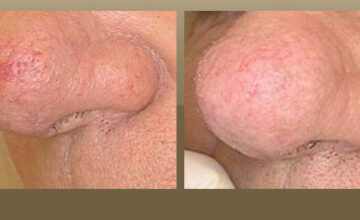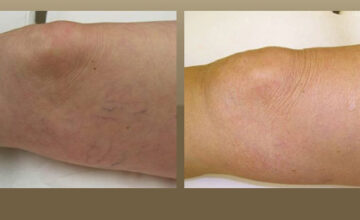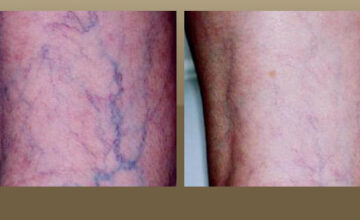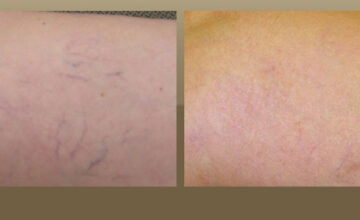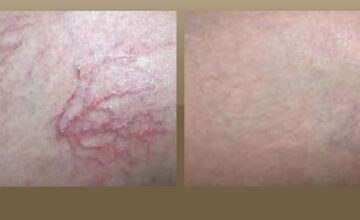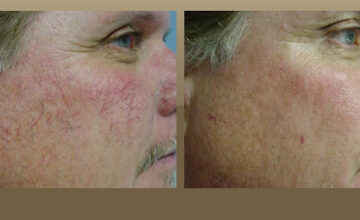Unsightly veins are benign vascular lesions including enlarged blood vessels and capillaries that appear on the surface of the skin as splotches, dots, bulges and spider shapes. They can show up in a variety of colors ranging from red to purple to brown. Weakness in the walls and valves of the veins cause blood to stagnate rather than to be properly circulated. Some vascular lesions are so tiny that they are not visible under normal conditions. Others, such as varicose leg veins can be quite prominent. These unsightly veins can be treated with Skinpeccable’s state of the art Laser Vein Removal.
Laser Vein Removal Video Procedures
How to Remove Spider Veins
How to Cure Spider Veins
Laser Vein Removal FAQ
A: These benign vascular lesions include enlarged blood vessels and capillaries that appear on the surface of the skin as splotches, dots, bulges and spider shapes. They can show up in a variety of colors ranging from red to purple to brown. Weakness in the walls and valves of the veins cause blood to stagnate rather than to be properly circulated. Some vascular lesions are so tiny that they are not visible under normal conditions. Others, such as varicose leg veins can be quite prominent.
A: Laser therapy treats many types of leg and face veins, including shallow spider veins and reticular veins. Spider Veins are very small veins caused by a dilation of the small venules under the skin. This occurs when the pressure inside the vein increases enough to overcome normal resistance of the vein wall. The ability of veins to resist increased pressure is reduced in women when the body’s estrogen level is reduced. Reticular Veins are small, bluish-colored veins that carry blood to the skin venules and are larger than spider veins. These veins have thin walls and dilate with excessive venous pressure. When this occurs, they become large enough to be unsightly, but are not considered to be varicose veins.
A: Lasers are used to treat larger, deeper veins. These veins respond to the precise energy level and wavelength of light that is used. A small spot of laser light travels through the skin, and is absorbed by the blood within the vein. The resulting heat coagulates or clots the blood, and destroys the function of the vein. This process does not affect the surrounding tissue. Over time, the vein is absorbed by the body and disappears from sight.
A: Patients do not have to change their normal routines before or after treatment. Sun exposure must be limited prior to and following any type of laser or IPL treatment. Treatment should not be performed on tanned skin.
A: The number of treatments necessary to resolve your vein concerns depends on the size of the vein and your body’s ability to heal. During your consultation, you will be given an estimate of the number of treatments required to obtain optimal results.
A: Treatment may vary from 15 to 30 minutes. As a result of treatment, the walls of the veins are damaged by the laser’s heat. The body next induces a healing process. The veins shrink and become less visible or disappear altogether. Medical studies have documented exceptional results on veins with laser treatments. Utilizing a laser allows customized treatment of virtually every small vein disorder, including deep veins and veins that do not respond to other treatment methods.
A: The beauty of this treatment is that there is no down time involved. You can resume regular activities immediately. Pain is generally mild. Redness, swelling and mild bruising can occur, but most always resolve over time. Limiting sun exposure will greatly minimize the risk of complications.
Avoid Retin-A, Affirm, Differin, Tazorac, Benzoyl Peroxide, Glycolic Acid, Alpha Hydroxy, Salicylic Acid, Astringents, Toners, Renova, and Prevage on treated area(s) for a minimum of 7 days after treatment and seven days before next treatment.
- Avoid sun exposure in the area to be treated for at least 3 weeks prior to your next treatment
- Avoid sun tanning, tanning beds, and tanning creams
- Men: Shave beard hair in area to be treated
- Wear sunscreen (SPF 30 or greater) recommended by your Skinpeccable provider
- Remove make-up, deodorants, and lotions.
- If getting treated on the face and you have a history of cold sores, take cold sore medicine (eg. Valtrex) as directed by the physician.
- You have been in the sun, have visited a tanning bed, or are using tanning creams
- You have started oral antibiotics (Minocycline, Tetracycline, etc.) or Accutane
- You have started Retin-A, Affirm, Differin, Tazorac, or Renova on the areas to be treated
- You are pregnant or are unsure if you are pregnant
- You have an active cold sore. An active cold sore is a contraindication to laser treatments on the face.

